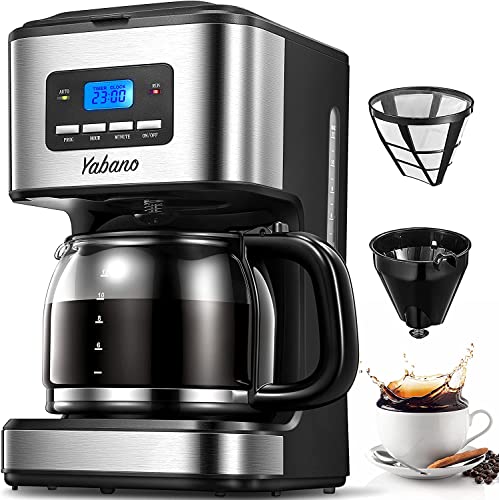Guide To Coffee Machine Drip: The Intermediate Guide The Steps To Coff…
페이지 정보

본문
How to Prevent Coffee Machine Dribble
A drip coffee maker enables you to make anywhere from a single cup to a full carafe with the flick of a dial. They offer programmable options and easy cleaning.
 A drip brew coffeemaker is a tube of water and then runs through a heating unit. Then the water is dispersed into the filter basket.
A drip brew coffeemaker is a tube of water and then runs through a heating unit. Then the water is dispersed into the filter basket.
1. Improper Filter Placement
The brewing of espresso and coffee is based on the drippy water being heated up over the ground coffee in the filter. The coffee that is brewed is dispersed into carafes or cups. The quality of the extraction is affected by many factors, including the ratio of ground coffee to water, the temperature and brewing time. This is why it's important for baristas to know the fundamentals of coffee brewing and how these elements influence each other to create excellent tasting coffee.
One of the most frequent reasons for a coffee maker to drip is a simple error in the process of preparing or placing the timer filter coffee machine. When preparing a filter, it is important to follow the guidelines that are provided by the manufacturer in order to ensure that the filter is positioned correctly. If you're not sure how to do this, it might be beneficial to consult an experienced technician for assistance.
A blocked or clogged filter is a different cause of drips. This could be due to a number of factors that include mineral accumulation. It is therefore essential to use water filters made specifically for coffee machines. This will prevent the accumulation of minerals like magnesium and chlorine, which can have a negative impact on the flavor and consistency.
If your coffee maker leaks dirty water, this could be due to a clogged drainage line or plumbing system leak. It is essential to look for obstructions in the reservoir of water and to examine the gaskets and seals regularly for wear. Backflushing your machine every day will identify any issues before they develop. In addition, it's a good idea have your machine professionally descaled on a regular basis, to help prevent the build-up of minerals that could lead to a clogged or damaged filter.
2. Clogged Filter
One of the most frequent reasons coffee machine drip occurs is because a filter has become blocked. To avoid this, ensure that you regularly clean the filter and ensure that it's the right size for your machine. This will help to reduce the risk of overflows that could cause costly repairs and replacements.
A too-fine grind can also cause clogging of filters. This can interfere with the flow of water, stopping it from flowing through the flavoured filter coffee. Try using a coarser grind or lowering the temperature of the water to fix this problem.
A clogged filter could be caused by folds or residue inside the filter, which can block the flow of water and cause overflow. To eliminate this buildup just soak the filter coffee maker machine in a mixture of white vinegar distilled and water (1:1) for a few hours. This will remove any excess oil and residue that could be causing the overflow.
A lid that isn't aligned properly or tabs could cause obstruction to the air filter. Check the lid and the filter to ensure they're properly positioned, and replace them if necessary.
If the overflow problem continues you should check the coffee maker's water pipe to make sure it's clear and allowing water to flow through. If this happens, regular maintenance and descaling can prevent it from happening. If it occurs, it's essential to take the water tank, inspect and clean the tube.
Finally, if the coffee maker's spout is leaky, it's likely that the drain hose has become blocked or bent. Pouring a solution that dissolves in espresso cleaner or cleaning the spout with hot water is a simple fix for this problem.
3. Improper Assembly
In many cases, simple mistakes like spouts that are not aligned properly are easily rectified by an experienced technician. It is crucial to check the machine regularly to ensure that it is properly assembled. Ensure that the water pathway and the brewing system are not obstructed by blockages. This will help to avoid leaks and ensure that the entire system is working efficiently.
Check that the spout at the front of the machine has been aligned correctly. If not, the water/coffee might be pushed into the door near several electronic sensors, and this could short out or cause permanent damage.
It is also crucial to regularly empty and check the components that are removable like the filter basket and the water tank. Regularly cleaning and emptying these components can help to avoid clogs that may cause problems with the flow of water and coffee through the machine. It's also recommended to regularly grease the gasket with food-safe lubricant in order to maintain its functionality and extend its life.
It is an excellent idea to empty and clean the grounds drawer and drip tray on a regular basis. If your coffee maker displays an error message saying "Empty Grounds Drawer/Empty Drip Tray", it's likely that a sensor is damaged. This can be corrected by replacing the sensor with a new one that is specifically made specifically for this model.
Always ensure whether the appliance is connected into an electrical source. It might seem obvious, but it is a common issue that is often ignored. If you still have problems it's recommended for you to contact the company that supplied your espresso or drip machine. They can provide detailed instructions over the phone on how to solve technical problems. They may also recommend technicians if they believe that your equipment is beyond repair.
4. Clogged Carafe
Over time the drip coffee machine can build up minerals in its tubes and carafe. This can affect the flavor and functionality of the machine. The best way to prevent this is to regularly clean and descaling. This involves filling the reservoir tank with a mixture of water and vinegar, and running a brew cycle without coffee grounds. This allows the vinegar to circulate throughout the system and break down any mineral deposits or obstructions.
A gurgling sound during the brewing process can suggest obstruction within the tube that is dispensing the water. This could occur if the tube's lip is not in the correct shape or material. It could also be caused due to a low temperature or hardness, as well as other factors. A blocked tubing can block water from entering the container, causing overheating and boiling. This then causes scalding to coffee.
If your carafe starts to look dirty, you can clean it using warm, soapy, water and baking soda. If you have stains that are tough to remove you can try swirling a little bit of plain white rice around with the water in the carafe. This can help to loosen stubborn gunk without harsh chemicals.
Although many people are now using other methods of making coffee drip machines are still a popular option. It is simple to use and cost-effective however it requires maintenance to ensure that the coffee comes out tasting great. To avoid damage and clogs it is important to clean the drip machine regularly and store it properly. It is also crucial to clean the grounds as well as the coffee residue that is left after brewing, as this can aid in the growth of yeast and bacterial growth.
5. Clogged Warming Plate
When a coffeemaker clogs, it's often because of mineral deposits. When water is heated, it releases some of the minerals and particles that are dissolving in it. This can damage the internal components of the machine and affect the flavor of the beverage. Descale your machine frequently to avoid any of these problems. Make sure you use descalers that are safe for your device.
If your machine is leaking water, then shut it off and let the reservoir or tank empty into the sink. This will prevent the formation of puddles underneath your coffeemaker, posing a safety hazard. Then, look at the leak area to determine if it's from a faulty seal. If you find a defective seal, it's a straightforward fix and getting a replacement isn't a problem.
If you notice that water is accumulating around the bottom of your device, it may be a sign that there's an issue with the high temperature tubing that is in the base. This could happen if the tubes are not firmly connected or have become loose due to the constant movement and frequent use of the device. Replace the tubing if necessary. Examine it for signs of wear.
Your coffee maker will last for a long time if you take care of it. If you're not handy, or just want to ensure that your device is maintained, you need to seek out a professional for an extensive inspection and maintenance. Contact the team at Corporate Coffee Solutions to arrange an appropriate maintenance plan that is tailored to your specific workplace's needs for brewing!
A drip coffee maker enables you to make anywhere from a single cup to a full carafe with the flick of a dial. They offer programmable options and easy cleaning.
 A drip brew coffeemaker is a tube of water and then runs through a heating unit. Then the water is dispersed into the filter basket.
A drip brew coffeemaker is a tube of water and then runs through a heating unit. Then the water is dispersed into the filter basket.1. Improper Filter Placement
The brewing of espresso and coffee is based on the drippy water being heated up over the ground coffee in the filter. The coffee that is brewed is dispersed into carafes or cups. The quality of the extraction is affected by many factors, including the ratio of ground coffee to water, the temperature and brewing time. This is why it's important for baristas to know the fundamentals of coffee brewing and how these elements influence each other to create excellent tasting coffee.
One of the most frequent reasons for a coffee maker to drip is a simple error in the process of preparing or placing the timer filter coffee machine. When preparing a filter, it is important to follow the guidelines that are provided by the manufacturer in order to ensure that the filter is positioned correctly. If you're not sure how to do this, it might be beneficial to consult an experienced technician for assistance.
A blocked or clogged filter is a different cause of drips. This could be due to a number of factors that include mineral accumulation. It is therefore essential to use water filters made specifically for coffee machines. This will prevent the accumulation of minerals like magnesium and chlorine, which can have a negative impact on the flavor and consistency.
If your coffee maker leaks dirty water, this could be due to a clogged drainage line or plumbing system leak. It is essential to look for obstructions in the reservoir of water and to examine the gaskets and seals regularly for wear. Backflushing your machine every day will identify any issues before they develop. In addition, it's a good idea have your machine professionally descaled on a regular basis, to help prevent the build-up of minerals that could lead to a clogged or damaged filter.
2. Clogged Filter
One of the most frequent reasons coffee machine drip occurs is because a filter has become blocked. To avoid this, ensure that you regularly clean the filter and ensure that it's the right size for your machine. This will help to reduce the risk of overflows that could cause costly repairs and replacements.
A too-fine grind can also cause clogging of filters. This can interfere with the flow of water, stopping it from flowing through the flavoured filter coffee. Try using a coarser grind or lowering the temperature of the water to fix this problem.
A clogged filter could be caused by folds or residue inside the filter, which can block the flow of water and cause overflow. To eliminate this buildup just soak the filter coffee maker machine in a mixture of white vinegar distilled and water (1:1) for a few hours. This will remove any excess oil and residue that could be causing the overflow.
A lid that isn't aligned properly or tabs could cause obstruction to the air filter. Check the lid and the filter to ensure they're properly positioned, and replace them if necessary.
If the overflow problem continues you should check the coffee maker's water pipe to make sure it's clear and allowing water to flow through. If this happens, regular maintenance and descaling can prevent it from happening. If it occurs, it's essential to take the water tank, inspect and clean the tube.
Finally, if the coffee maker's spout is leaky, it's likely that the drain hose has become blocked or bent. Pouring a solution that dissolves in espresso cleaner or cleaning the spout with hot water is a simple fix for this problem.
3. Improper Assembly
In many cases, simple mistakes like spouts that are not aligned properly are easily rectified by an experienced technician. It is crucial to check the machine regularly to ensure that it is properly assembled. Ensure that the water pathway and the brewing system are not obstructed by blockages. This will help to avoid leaks and ensure that the entire system is working efficiently.
Check that the spout at the front of the machine has been aligned correctly. If not, the water/coffee might be pushed into the door near several electronic sensors, and this could short out or cause permanent damage.
It is also crucial to regularly empty and check the components that are removable like the filter basket and the water tank. Regularly cleaning and emptying these components can help to avoid clogs that may cause problems with the flow of water and coffee through the machine. It's also recommended to regularly grease the gasket with food-safe lubricant in order to maintain its functionality and extend its life.
It is an excellent idea to empty and clean the grounds drawer and drip tray on a regular basis. If your coffee maker displays an error message saying "Empty Grounds Drawer/Empty Drip Tray", it's likely that a sensor is damaged. This can be corrected by replacing the sensor with a new one that is specifically made specifically for this model.
Always ensure whether the appliance is connected into an electrical source. It might seem obvious, but it is a common issue that is often ignored. If you still have problems it's recommended for you to contact the company that supplied your espresso or drip machine. They can provide detailed instructions over the phone on how to solve technical problems. They may also recommend technicians if they believe that your equipment is beyond repair.
4. Clogged Carafe
Over time the drip coffee machine can build up minerals in its tubes and carafe. This can affect the flavor and functionality of the machine. The best way to prevent this is to regularly clean and descaling. This involves filling the reservoir tank with a mixture of water and vinegar, and running a brew cycle without coffee grounds. This allows the vinegar to circulate throughout the system and break down any mineral deposits or obstructions.
A gurgling sound during the brewing process can suggest obstruction within the tube that is dispensing the water. This could occur if the tube's lip is not in the correct shape or material. It could also be caused due to a low temperature or hardness, as well as other factors. A blocked tubing can block water from entering the container, causing overheating and boiling. This then causes scalding to coffee.
If your carafe starts to look dirty, you can clean it using warm, soapy, water and baking soda. If you have stains that are tough to remove you can try swirling a little bit of plain white rice around with the water in the carafe. This can help to loosen stubborn gunk without harsh chemicals.
Although many people are now using other methods of making coffee drip machines are still a popular option. It is simple to use and cost-effective however it requires maintenance to ensure that the coffee comes out tasting great. To avoid damage and clogs it is important to clean the drip machine regularly and store it properly. It is also crucial to clean the grounds as well as the coffee residue that is left after brewing, as this can aid in the growth of yeast and bacterial growth.
5. Clogged Warming Plate
When a coffeemaker clogs, it's often because of mineral deposits. When water is heated, it releases some of the minerals and particles that are dissolving in it. This can damage the internal components of the machine and affect the flavor of the beverage. Descale your machine frequently to avoid any of these problems. Make sure you use descalers that are safe for your device.
If your machine is leaking water, then shut it off and let the reservoir or tank empty into the sink. This will prevent the formation of puddles underneath your coffeemaker, posing a safety hazard. Then, look at the leak area to determine if it's from a faulty seal. If you find a defective seal, it's a straightforward fix and getting a replacement isn't a problem.
If you notice that water is accumulating around the bottom of your device, it may be a sign that there's an issue with the high temperature tubing that is in the base. This could happen if the tubes are not firmly connected or have become loose due to the constant movement and frequent use of the device. Replace the tubing if necessary. Examine it for signs of wear.
Your coffee maker will last for a long time if you take care of it. If you're not handy, or just want to ensure that your device is maintained, you need to seek out a professional for an extensive inspection and maintenance. Contact the team at Corporate Coffee Solutions to arrange an appropriate maintenance plan that is tailored to your specific workplace's needs for brewing!
- 이전글조개파티 도메인 ※링크나라※ 주소모음 세모링 링크모음 24.11.22
- 다음글Guide To Coffee Machine Drip: The Intermediate Guide For Coffee Machine Drip 24.11.22
댓글목록
등록된 댓글이 없습니다.




